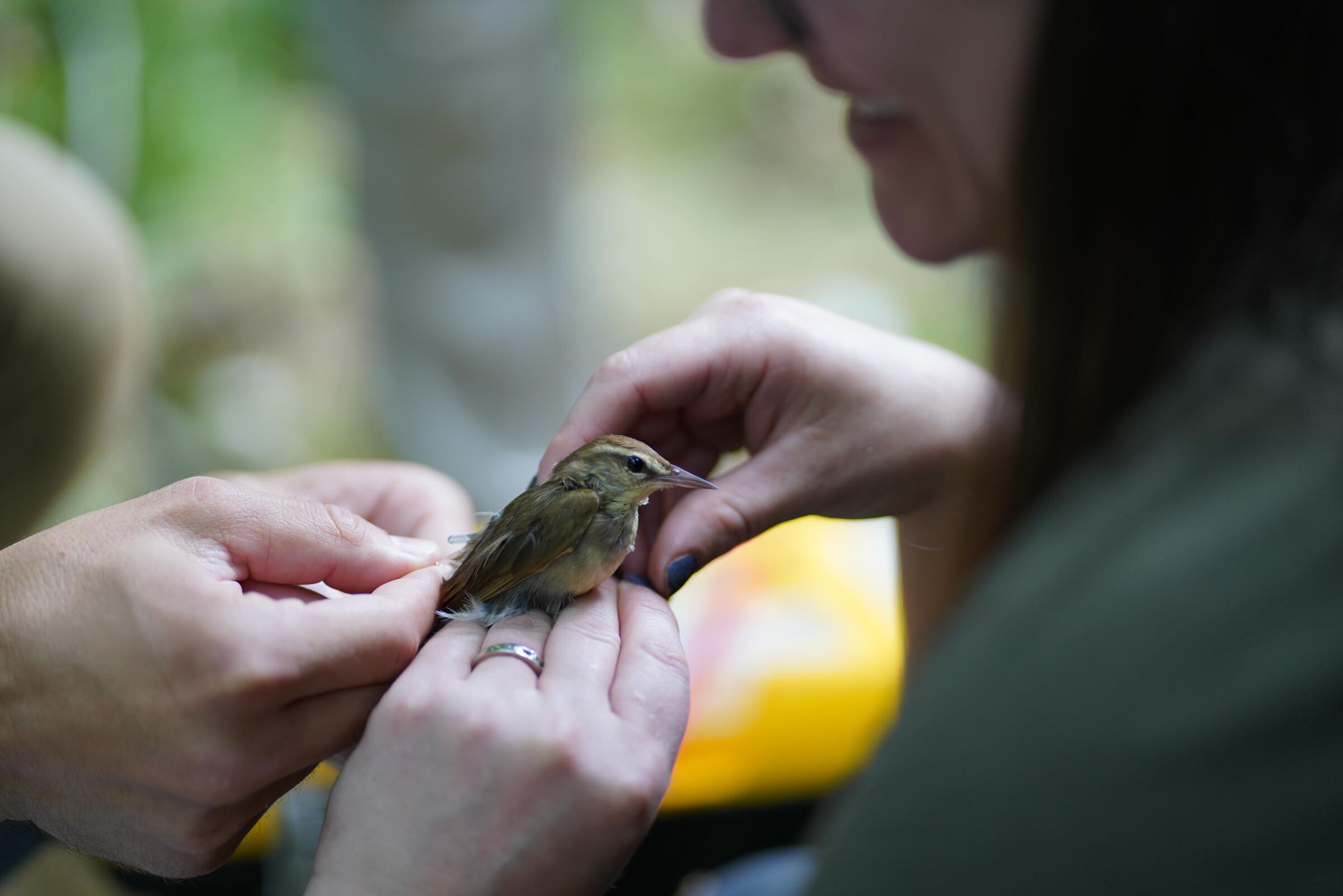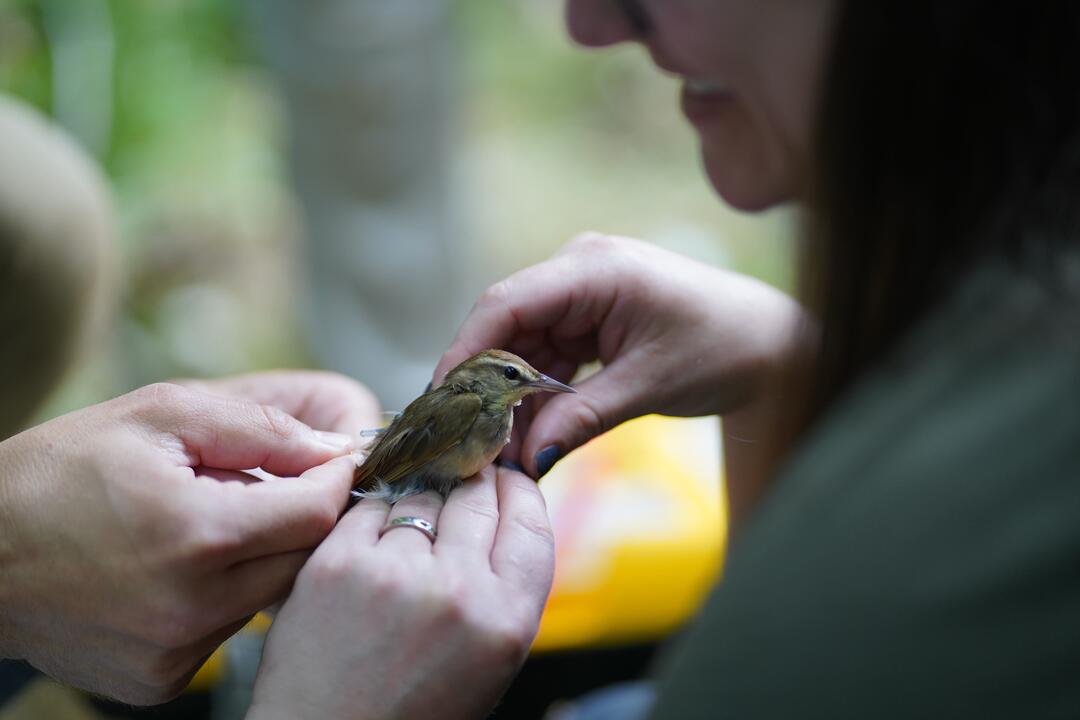Audubon South Carolina has partnered with several other institutions including Audubon Louisiana, University of Tennessee, Virginia Commonwealth University, Virginia Tech, Arkansas State University, and Louisiana State University to pursue the effort to better understand a crucial part of the Swainson’s Warbler’s (Limnothlypis swainsonii) life history: migration. This species is considered a bird of conservation concern and a priority species for the National Audubon Society. Swainson’s Warblers are ground-dwelling, neotropical migrants that breed in the Mississippi Alluvial Valley, Atlantic Coastal Plain, and southern Appalachian Mountains. This species nests in bottomland hardwood forests with a well-developed canopy, dense understory, and extensive leaf litter.
Audubon South Carolina’s Healthy Forests program has developed “bird-friendly” forestry practices that encourage the development of habitat for several priority species that rely on bottomland hardwood forests, including Swainson’s Warblers, while also allowing private landowners to manage their property in a way that that is ecologically and economically beneficial.
Their habitat consists of a forested canopy with a dense, many times impenetrable understory, paired with their secretive nature and small population size, these factors challenge efforts to study their migration ecology which is crucial to full lifecycle conservation efforts. This project, designed and researched by Garret Rhyne, a graduate student at Louisiana State University, utilizes light-level geolocators and Motus nanotags deployed onto individual birds across their entire breeding range.
Light-level geolocators, or global location sensors, are lightweight devices (0.3 grams) that use daylight to estimate location. A light-level geolocator has a light sensor, an internal clock, a battery and a computer that stores measurements of light. The batteries will last at least a year and the birds must be recaptured during the next breeding season in order to retrieve the data from these devices. Due to the challenges that arise with recapture success, 87 total geolocators have been deployed across the southeast to ensure an adequate sample will be recovered next season.
In contrast, Motus nanotags do not need to be recovered to gather data collected throughout their lifespan. The Motus Wildlife Tracking System (Motus) utilizes automated radio telemetry to simultaneously track hundreds of individuals of numerous species of birds, bats, and insects. Over 1,100 Motus receiver stations exist across 4 continents and 31 countries. Once a nanotag is deployed on an animal, in a similar fashion as the geolocator, it will wear the tag for the rest of its life, or until the tag falls off from deterioration, and data will continue to transmit location data any time it flies past a receiver tower within the Motus network. Larger units for larger birds are now equipped with solar charging features that extend the life of the tag.
As a partner in this migratory connectivity project, Audubon South Carolina received 10 geolocators to deploy in 2021 and recover in 2022, as well as 4 nanotags. Since this species is secretive and uses somewhat changing adventitious habitats, we used multiple locations to deploy the units. Our first deployments occurred in Dorchester Co., SC within the boundaries of our property in Four-Holes Swamp, near Beidler Forest where the habitat occurs naturally. Three geolocators were deployed on the Edisto Nature Trail in Colleton Co., SC near Jackson.
Silver Bluff Audubon Center and Sanctuary, in Aiken Co., SC, is our center along the Savannah River that is home to 3,400 acres of Longleaf Pine savanna, grasslands, and bottomland Hardwood Forests. One particular peninsula of the sanctuary along the river once was home to Swainson’s Warblers. Over time as the forest matured the thick understory of young trees was lost, and the Swainson’s disappeared from this property. With the development of the Bird Friendly Forestry recommendations, Silver Bluff used this area as a demonstration site to implement these forest management practices recreating the habitat Swainson’s Warblers need. As they say, if you build it, they will come, and boy did they. This demonstration site had numerous singing Swainson’s Warblers defending territories just a few years after the bird-friendly practices were implemented. Bird Friendly Forestry practices worked like a charm to create the right mix of closed canopy, understory, and leaf litter that Swainson’s require for nesting. Now that we’ve created the habitat for these birds, and they’ve arrived and enthusiastically set up territories, we’ve deployed three Geolocators on the demonstration site.
On the same day we deployed these geolocators, we began assembling our new Motus Tower at the visitors center funded by Dominion Energy. Sanctuary Manager Brandon Heitkamp, Sanctuary Staff Travis Scott, and our Seasonal Forestry Intern Orum Snow, mounted the tower atop a utility pole and plugged the tower in to go live! Since then, we’ve returned to find two more Swainson’s Warblers who haven’t been outfitted with a geolocator yet, and we attached a nanotag that will be detected by the tower at the center. Ideally, we’ll get a good picture of how late these birds stay in their breeding territory, and when they depart Silver Bluff. With any luck, it’ll ping another tower along the way and help fill in gaps of knowledge about where, when, and how quickly these birds migrate.
A second tower is in the works for Beidler Forest through a partnership with Dorchester County Career & Technical Center. We hope to bring another STEM-based learning experience to the students there, as well as monitor for migrating birds using Francis Beidler Forest as migratory stop over habitat to highlight the value of intact forests to migration ecology.
The last two nanotags were deployed at Bray’s Island and Nemours Wildlife Foundation in Beaufort Co., SC. Nemours installed a Motus tower last year, and luckily also has Swainson’s Warbler habitat and confirmed individuals on campus. Brays Island falls within the detection region of the Nemours tower, and is also home to a few Swainson’s Warblers according to island Naturalist Jake Zadik. In addition to location data, we are collecting various morphological measurements and documenting detailed descriptions of each individual’s habitat type. With the data collected over the next year, our efforts will aid in the identification of the overwintering sites, migration routes, and quantify the migratory connectivity between breeding populations of Swainson’s Warblers. The information gained from this study will assuredly help inform conservation efforts for this species by providing the locations of essential habitat along their migration routes. The data will also contribute to the Migratory Bird Initiative, led by the National Audubon Society, to combine all known data sets for these migratory species into one comprehensive platform to get the clearest picture of what these birds are doing, the hazards they face and the stopover locations that seem most critical to protect.
It’s a beautiful thing when scientists across a species range can collaborate to piece together the puzzle on this small elusive warbler that eludes so many birders. It’s exciting to hear one or two in a year for many birders, it’s another thing to see one, and it’s mind blowing to have had 15+ Swainson’s Warblers in our hands this year. The presence of these ghost birds signifies how proper habitat management, bird friendly forestry, and land protection can mean the world to a little brown bird and the birders who seek them.







